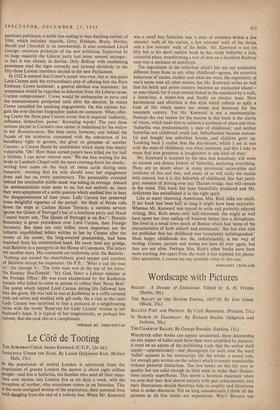Le Cote de Tooting
THE SUBURBAN CHILD. James Kenward. (C.U.P., 12s. 6d.)
INNOCENCE UNDER THE ELMS. By Louise Dickinson Rich. (Robert Hale, 15s.)
IF the population of central London is subtracted from the Population of greater London the answer is about eight million People—and this is Suburbia, the families who send all their mem- bers over sixteen into London five or six days a week, with the exception of mother, who sometimes comes in on Saturday. This is the most maligned section of the population, their personal lives held dangling from the end of a railway line. When Mr. Kenward
was a small boy Suburbia was 'a state of existence within a few minutes' walk of the station, a few minutes' walk of the shops, and a few minutes' walk of the fields.' Mr. Kenward is not yet fifty but in his short mellow book he has made Suburbia a rich, colourful place, transforming a row of dots on a Southern Railway map into a necklace of amethysts. .
The ingredients in the suburban child's life are not noticeably different from those in any other childhood—games, the eccentric behaviour of uncles, mother and what she wore, the superiority of one's nurse over all other nurses, but Mr. Kenward writes so well that his brick and privet country becomes an enchanted island— or near-island, for it must remain linked to the mainland by a walk, a horse-bus, a motor-bus and finally an electric train. How harmonious and effortless is this style which reflects so aptly a kind of life which seems too serene and balanced for the twentieth century. Yet Mr. Kenward is not a sentimentalist. Perhaps the real reason for his success in this book is the clarity of vision, which leads him to achieve a synthesis of place and time. 'Suburbia was predominantly a state of childhood,' and neither Suburbia nor childhood could last. Suburbanites became success- ful and bought less suburban houses, and children grew up. 'Looking back I realise that the day-dream, which I see at one with the state of childhood, was what mattered, and this I take to mean that true greatness is imaginative in any kind of state.'
Mr. Kenward is haunted by the idea that somebody will write an earnest and dreary history of Suburbia, analysing everything. Plans are no doubt afoot in many provincial universities and institutes of this and that, and many of us will study the results with interest, but it is this Suburbia of childhood, like that pearl- grey moment of driving ever any Thames bridge, that will remain in the mind. This book has been beautifully produced and Mr. Ardizzone has embellished it in the right spirit.
Like so many charming Americans, Mrs. Rich talks too much. If her book had been half as long it might have been enjoyable. Whereas Mr. Kenward was moved to write and probably enjoyed writing, Mrs. Rich seems only half-interested; she might as well have spent her time reeling off business letters into a dictaphone. She lived in a small town south of Boston which had 'some of the characteristics of both suburb and crossroads.' She has also told her publisher that her childhood was 'completely indistinguished.' Most happy childhoods are. So, unfortunately, is her way of writing. Games, parents and nurses are here all over again, but they are not alive. Perhaps Mrs. Rich's other books have been more exciting, but apart from the work it has supplied for photo- litho specialists, I cannot see any possible value in this one.
MARGARET CROSLAND


































 Previous page
Previous page